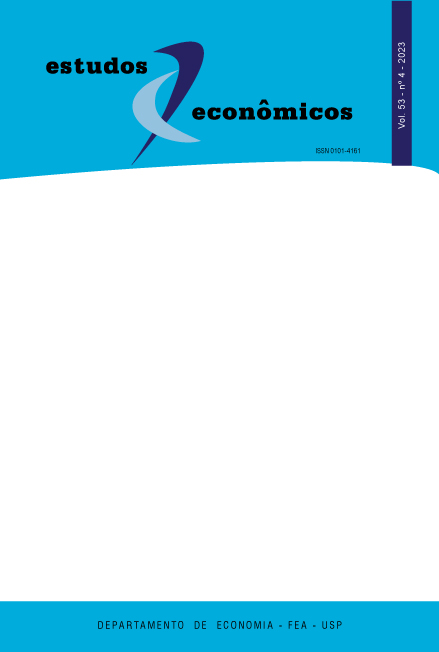Mensurando impactos de políticas nacionais em uma região: SAMBA+REG
DOI:
https://doi.org/10.1590/1980-53575345cifjvPalavras-chave:
SAMBA, Modelos DSGE, Economia regionalResumo
Este artigo apresenta uma metodologia empírica para analisar a propagação de choques agregados entre regiões. Embora focando especificamente no caso do Brasil e do Ceará, a metodologia proposta pode ser facilmente adaptada para examinar outras regiões também. Desenvolvemos um modelo dinâmico, chamado SAMBA+REG, que complementa o modelo DSGE do Banco Central do Brasil (SAMBA) ao incorporar elementos regionais. Esse arcabouço teórico nos permite explorar como choques agregados impactam uma região específica. Realizamos simulações de choques fiscais e monetários, e os resultados estão alinhados com a literatura existente. O SAMBA+REG não apenas facilita a avaliação dos efeitos das políticas econômicas do governo central em uma economia regional, mas também oferece insights sobre várias estratégias para os governos estaduais responderem de forma eficaz a essas políticas.
Downloads
Referências
Adolfson, M., et al. “Evaluating an estimated new Keynesian small open economy model.” Journal of Economic Dynamics and Control 32, no. 8 (2008): 2690-2721.
An, S., & Schorfheide, F. “Bayesian analysis of dsge models.” Econometric Reviews 26, no. 2-4 (2007): 113-172.
Antosiewicz, Marek, & Kowal, Pawel. “MEMO III-A large scale multi-sector DSGE model.” IBS: Warszawa, Poland, 2016.
Antosiewicz, Marek, Lewandowski, Piotr, & Witajewski-Baltvilks, Jan. “Input vs. Output taxation—A DSGE approach to modeling resource decoupling.” Sustainability 8, no. 4 (2016): 352.
Araújo, E., et al. “Measuring the regional impact of Brazilian monetary policy: a comparison between the northeast and south regions.” Economic Magazine of the Northeast 35, no. 3 (2004): 356-393.
Beraja, Martin, Hurst, Erik, & Ospina, Juan. “The aggregate implications of regional business cycles.” Econometrica 87, no. 6 (2019): 1789-1833.
Beraja, Martin, Hurst, Erik, Fuster, Andreas, & Vavra, Joseph. “REGIONAL HETEROGENEITY AND THE REFINANCING CHANNEL OF MONETARY POLICY.” The Quarterly Journal of Economics 109 (2019).
Bertanha, M., & Haddad, E. “The Regional Effects of Monetary Policy in Brazil: Impacts and Spatial Overflows.” Revista Brasileira de Economia 62 (2008): 3-29.
Bukowski, Maciej, & Kowal, Pawel. “Large scale, multi-sector DSGE model as a climate policy assessment tool.” Instytut Badań Strukturalnych, Warszawa, 3 (2010).
Cakici, M. F., & Cakici, S. M. “Financial integration and business cycles in a small open economy.” Journal of International Money and Finance 30, no. 7 (2011): 1280-1302.
Castro, M. R. D., et al. “Samba: Stochastic analytical model with a Bayesian approach.” Brazilian Review of Econometrics 35, no. 2 (2015): 103-170.
Christiano, L. J., Trabandt, M., & Walentin, K. “Introducing financial frictions and unemployment into a small open economy model.” Journal of Economic Dynamics and Control 35, no. 12 (2011): 1999-2041.
De Paoli, B. “Monetary policy and welfare in a small open economy.” Journal of International Economics 77, no. 1 (2009): 11-22.
Dubrovskaya, Julia, Shults, Dmitriy, & Kozonogova, Elena. “Constructing a Region DSGE Model with Institutional Features of Territorial Development.” Computation 10, no. 7 (2022): 105.
Jones, Callum, Midrigan, Virgiliu, & Philippon, Thomas. “Household leverage and the recession.” Econometrica 90, no. 5 (2022): 2471-2505.
Junior, C. J. J. C. “Stochastic shocks in world income and the effects on the Brazilian economy.” Economics & Technology Magazine, UFPR 9 (2013): 4.
Junior, L. d. S.M., Oliveira, C. d., & Jacinto, P. d. “The Role of Local Fiscal Policy in the Economic Growth of Cities: Empirical Evidence for Brazil.” National Economic Meeting, ANPEC 34 (2006).
Kydland, F. E., & Prescott, E. C. “Time to build and aggregate fluctuations.” Econometrica: Journal of the Econometric Society (1982): 1345-1370.
Long Jr, J. B., & Plosser, C. I. “Real business cycles.” The Journal of Political Economy (1983): 39-69.
Lucas Jr, R. “Econometric policy evaluation: A critique.” Carnegie-Rochester Series on Public Policy 1, no. 1 (1976): 19-46.
Marcellino, M., & Rychalovska, Y. “Forecasting with a dsge model of a small open economy within the monetary union.” Journal of Forecasting 33, no. 5 (2014): 315-338.
Miranda-Pinto, Jorge, & Young, Eric R. “Comparing dynamic multisector models.” Economics Letters 181 (2019): 28-32.
Okano, M., et al. “Development of a Regional DSGE Model in Japan: Empirical Evidence of Economic Stagnation in the Kansai Economy” (2015).
Paiva, W., et al. “A general equilibrium model for the state of Ceará: the static regional analysis model - mares/ce.” In: XIV MEETING CEARÁEM DEBATE, IPECE (2018).
Pan, Xiongfeng, et al. “Environmental expenditure spillovers: Evidence from an estimated multi-area DSGE model.” Energy Economics 86 (2020): 104645.
Pfeifer, J. “A Guide to specifying observation equations for the estimation of DSGE models” (2014).
Pizzuto, P. “Regional Effects of Monetary Policy in the US: An Empirical Re-assessment.” Economics Letters 190 (2020): 109062.
Rickman, D. S. “Modern Macroeconomics and Regional Economic Modeling.” Journal of Regional Science 50, no. 1 (2010): 23-41.
Serrano, F. M. “Regional Impact of Monetary Policy in Brazil: A Bayesian Approach.” Thesis (Doctorate) - University of São Paulo (2015).
Smets, F., & Wouters, R. “An Estimated Dynamic Stochastic General Equilibrium Model of the Euro Area.”
Journal of the European Economic Association 1, no. 5 (2003): 1123-1175.
Tamegawa, K. “Two-region dsge analysis of regionally targeted fiscal policy.” Review of Regional Studies 42, no. 3 (2012): 249-263.
Tamegawa, K. “Constructing a small region dsge model.” ISRN Economics 2013 (2013).
Varga, Janos, et al. “E-QUEST: A multisector dynamic general equilibrium model with energy and a model-based assessment to reach the EU climate targets.” Economic Modelling 114 (2022).
Downloads
Publicado
Edição
Seção
Licença
Copyright (c) 2023 Christiano Modesto Penna, Isadora Osterno, Flavio Ataliba, José Weligton Gomes, Vitor Monteiro

Este trabalho está licenciado sob uma licença Creative Commons Attribution-NonCommercial 4.0 International License.
A submissão de artigo autoriza sua publicação e implica o compromisso de que o mesmo material não esteja sendo submetido a outro periódico.
A revista não paga direitos autorais aos autores dos artigos publicados.
Dados de financiamento
-
Fundação Cearense de Apoio ao Desenvolvimento Científico e Tecnológico
Números do Financiamento 06849024/2019





 Atualizado em 14/08/2025
Atualizado em 14/08/2025